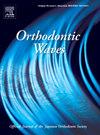Does corticotomy accelerate canine retraction with adequate anchorage control? A split mouth randomized controlled trial
IF 0.5
Q4 DENTISTRY, ORAL SURGERY & MEDICINE
引用次数: 4
Abstract
ABSTRACT Purpose: To assess the effects of corticotomy on the distal movement of canine and to assess the amount of molar anchor loss. Materials and Methods: 14 patients were selected for this prospective, split-mouth, randomized controlled trial. After bilateral maxillary first premolar extractions, corticotomy was done distal to canine on one side and 150 g of force was applied. The rate of canine and molar movement, tipping and rotation were evaluated for control and experimental side. The movement of canine and anchor loss was assessed at an interval of 3 weeks, using study models, till single canine retraction was complete. Subjective assessment of the post-surgical pain, swelling, discomfort and an overall patient perception of the surgical procedure was assessed at two time points. Results: There was a significant increase in the rate of canine movement on the experiment side at T1 and T2 (p ≤ 0.01). Anchor loss was found to be present on both the sides but the difference was not statistically significant (p > 0.05). The mesiodistal tipping of canine was found to be greater on the control side than the experiment side whereas there was no statistically significant difference in the mesiodistal tipping of the molar on either side (p > 0.05). The experiment group showed a greater rotation of canine than the control (p ≤ 0.05), however, the rotation of molar was statistically insignificant. Conclusion: Corticotomy-assisted canine retraction causes a significant increase in the rate of canine retraction for the initial 2 months of the post-corticotomy period.皮质切开术是否能在适当的锚定控制下加速犬的后缩?裂口随机对照试验
目的:探讨皮质切开术对犬远端运动的影响及磨牙锚的损失。材料和方法:选择14例患者进行前瞻性、裂口、随机对照试验。双侧上颌第一前磨牙拔除后,对一侧犬齿远端进行皮质切开术,施加150g的力。在控制侧和实验侧评估了犬齿和磨牙的运动速率、倾斜速率和旋转速率。使用研究模型每隔3周评估一次犬的运动和锚的损失,直到完成单犬的牵出。在两个时间点对术后疼痛、肿胀、不适和患者对手术过程的整体感知进行主观评估。结果:实验侧犬在T1和T2时的运动速率显著增加(p≤0.01)。双侧均出现锚失,但差异无统计学意义(p < 0.05)。对照组侧犬齿中远端倾斜度大于实验侧,而两侧磨牙中远端倾斜度差异无统计学意义(p < 0.05)。实验组犬齿旋转明显大于对照组(p≤0.05),磨牙旋转差异无统计学意义。结论:在皮质切开术后的最初2个月,皮质切开术辅助犬的牵回率显著增加。
本文章由计算机程序翻译,如有差异,请以英文原文为准。
求助全文
约1分钟内获得全文
求助全文
来源期刊

Orthodontic Waves
DENTISTRY, ORAL SURGERY & MEDICINE-
CiteScore
0.40
自引率
0.00%
发文量
0
期刊介绍:
Orthodontic Waves is the official publication of the Japanese Orthodontic Society. The aim of this journal is to foster the advancement of orthodontic research and practice. The journal seeks to publish original articles (i) definitive reports of wide interest to the orthodontic community, (ii) Case Reports and (iii) Short Communications. Research papers stand on the scientific basis of orthodontics. Clinical topics covered include all techniques and approaches to treatment planning. All submissions are subject to peer review.
 求助内容:
求助内容: 应助结果提醒方式:
应助结果提醒方式:


